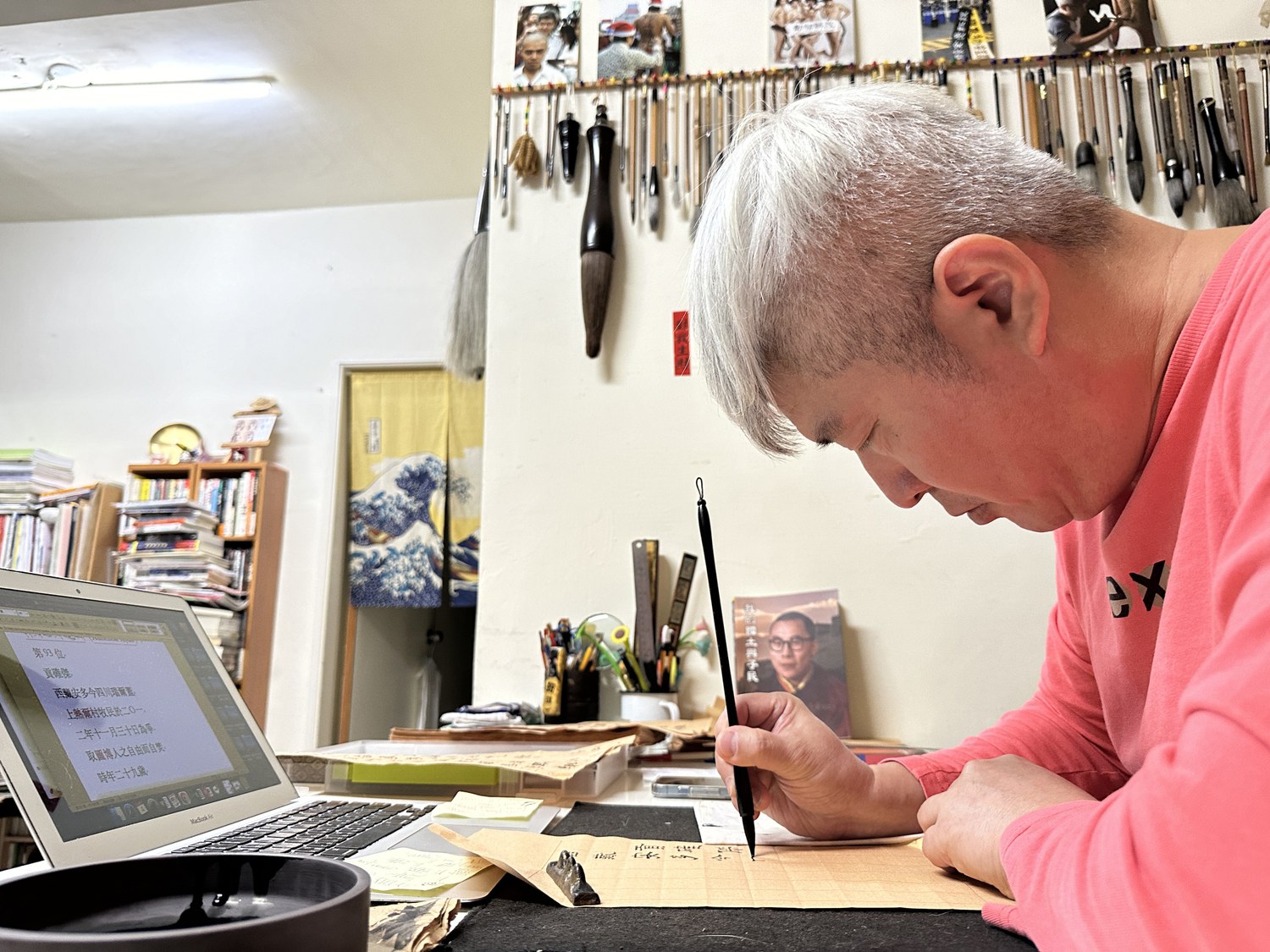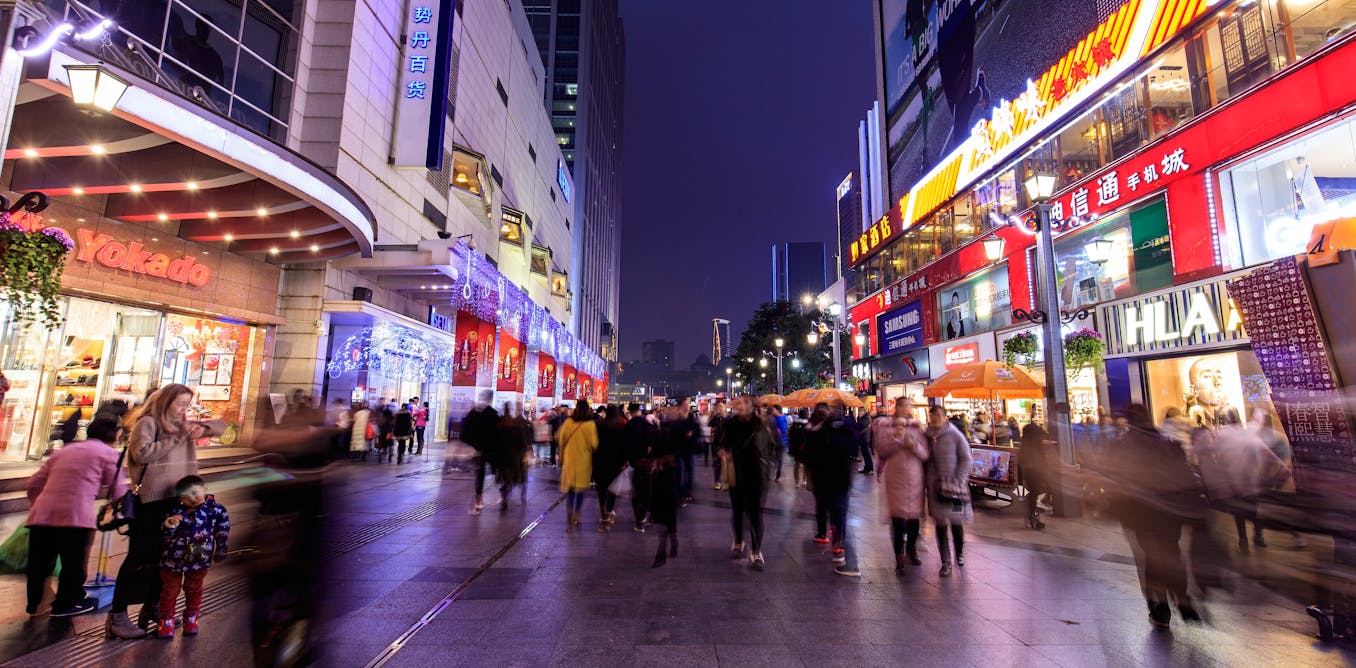China
Taiwan calligraphy exhibit honors Tibetans who self-immolated

On Sunday, Tibetans around the world will be protesting outside Chinese embassies around the world to mark International Human Rights Day.
There is no Chinese Embassy in democratic Taiwan, so the Dalai Lama Foundation will exhibit 166 works of calligraphy by Ho Tsung-hsun, with prayers and chants from five Buddhist teachers honoring the “heroes and martyrs” of the Tibetan resistance movement instead.
The exhibit – titled “Those Who Give Fearlessly” – will honor 166 Tibetans inside and outside China who have set themselves on fire as an act of resistance to Chinese Communist Party rule, and in pursuit of freedom, Ho told Radio Free Asia in a recent interview.
“I was very worried when I was doing this that people would think that I was encouraging self-immolation,” Ho said. “But these things happened – that’s a fact.”
“You can’t erase an entire nationality from the historical record who have made such sacrifices in pursuit of their freedom,” he said.
Ho made the exhibit not to advocate self-immolation, but to highlight the despair and helplessness of those who use it as a form of protest, he said.
“Self-immolation is a last-ditch choice – there must be so much going on in people’s minds that we can’t understand,” he said. “166 self-immolations in the space of just 10 years is a shocking number.”
“Cheng Nan-jung self-immolated right here in Taiwan, and we still see memorials to him here every year marking that day,” Ho said, in a reference to the 1989 self-immolation of the Taiwanese publisher, in a protest against the lack of free speech under authoritarian, one-party rule by the Kuomintang.
Writing history
Calligraphic inscriptions have been used since ancient times to record important events, whether on stone steles or on paper, Ho said.
He hopes that his imitation of ancient scrolls will pay due respect to the people who burned in the ultimate act of self-sacrifice.
Kelsang Gyaltsen, the Dalai Lama’s envoy to Taiwan, told Radio Free Asia he was moved by Ho’s tribute.
“These Tibetans are heroes as we define them in Tibet,” he said. “The Chinese government demonizes them as insane, or claims they acted out of desperation due to family or economic disputes, but it’s not that. No.”
“They sacrificed themselves for their country, and for their people.”

Kelsang Gyaltsen said the epithet, “Those who give fearlessly” is the highest level of almsgiving in the Buddhist tradition. “It means to give your life for a just cause,” he said.
Many of those who set fire to themselves did so while shouting slogans or leaving statements calling for freedom for Tibetans, or for the return of its exiled spiritual leader, the Dalai Lama, and the protection of Tibetans’ Buddhist and cultural heritage.
Some inscribed “Independence for Tibet” on their bodies, Kelsang Gyaltsen said.
Anyone who claims that just speaking of the self-immolations means encouraging them is engaging in pro-Beijing “cognitive warfare,” he added.
“Who is it who most wants to forget them? Who doesn’t want us to cherish or remember them? It’s the brutal Chinese Communist Party regime,” he said, calling for the anniversary of the first self-immolation – Feb. 27 – to be marked as “Tibetan Self-Immolation Day.”
Art as protest
Ho, who studied advertising and fine arts, started writing calligraphy in high school 40 years ago.
His calligraphy has graced a number of protests over the last three decades in Taiwan, including environmental protection and anti-nuclear campaigns, educational reform movements and political activism.

He has an abiding memory of one self-immolation – the second to take place in Tibet, in 2009 — in particular.
“Lobsang Phuntsok, who was only 20 years old at the time, self-immolated on March 16, which happened to be my birthday,” Ho said. “From then onwards, it seemed as if our souls were connected, and that was when I started to pay attention and care about what was happening.”
March 16 is also the anniversary of mass protests by Tibetans, including Buddhist monks and nuns in Ngaba, a Tibetan region of China’s southwestern province of Sichuan, in 2008, that were to be a turning point in the movement for a free Tibet.
“I was shocked, saddened and outraged by each self-immolation, especially during the nearly 90 self-immolations that took place in 2012 – at their peak, we were seeing nearly one a week,” Ho said.
Just thinking about the way Lobsang Phutsok died causes him pain to this day, he said.
Ancient style
Ho’s exhibit will display 166 records of self-immolation by Tibetans using paper and a calligraphic style that matches the style of ancient official records.
Each piece is 34 cm long and 18.5 cm wide (13 x 7 inches). Each work shows the person’s name, place of birth, identity and age of self-immolation.
Ho’s exhibit also has the blessing of the Tibetan government-in-exile’s envoy to Taiwan, who suggested he make sure Tibetans are the central subjects of the work, and add the ancient Tibetan place-names from when the region was a sovereign and independent country, alongside the modern place-names that are used under Chinese rule.
One record reads: “Lobsang Tashi, a monk from Amdo in today’s Sichuan, was 24 years old when he set himself on fire on Feb. 27, 2009, to fight for the freedom of Tibetans.”
Every one of the 166 self-immolators, who include elderly in their 80s, 16-year-old students, high-ranking Buddhist teachers, or Rinpoche, monks, nuns, students and women, is given equal weighting in the exhibit, with a word limit of 43 to 46 words each, Ho said.
The process has been a harrowing one at times for Ho, who got horribly stuck on the record for 49-year-old herder Namlha Tsering, the 104th Tibetan to self-immolate.
He kept making errors on this record, missing out words each time he tried to copy it.
“Namlha Tsering…
Read the rest of this article here >>> Taiwan calligraphy exhibit honors Tibetans who self-immolated
Business
HSBC Chairman to Head Key UK Business Delegation to China

HSBC Chairman Mark Tucker will lead a UK business delegation to China next month to boost trade and investment, amid concerns over national security and improving UK-China relations.
HSBC Chairman Leads UK Delegation to China
HSBC Chairman Mark Tucker will lead a pivotal British business delegation to China next month, marking the first significant visit since 2018. The trip aims to enhance Chinese investment in the UK, guided by Chancellor Rachel Reeves. Tucker, a seasoned financier with extensive Asia experience, is regarded as essential in resetting UK-China relations.
Reviving Economic Dialogue
Tucker will accompany senior bankers in seeking to rejuvenate trade, specifically focusing on financial services. Although there are apprehensions among some UK lawmakers regarding national security threats posed by closer ties to Beijing, the UK Treasury spokesperson confirmed Chancellor Reeves’ upcoming discussions on economic cooperation in Beijing.
A Shift in UK-China Relations
Since suspending most dialogues following China’s imposition of a national security law in Hong Kong, UK-China relations have soured. Nevertheless, the Labour government is prioritizing improved ties with China, emphasizing investment opportunities. Reeves asserts the necessity of a pragmatic approach to benefitting national interests amid ongoing concerns voiced by some lawmakers about security risks.
Source : HSBC Chairman to lead pivotal UK business delegation to China
China
China’s November 2024 Economy: Navigating Mixed Signals and Ongoing Challenges

In November 2024, China’s economy exhibited mixed results: industrial production rose by 5.4%, while retail sales grew only 3%, below forecasts. Fixed asset investment also faltered. Policymakers are anticipated to introduce measures to stimulate domestic demand and combat deflation.
China’s economy showed mixed performance in November 2024, with industrial production and exports showing resilience, while retail sales and fixed asset investment underperformed, amid ongoing challenges in the property sector. Policymakers are expected to implement targeted fiscal and monetary measures to boost domestic demand and address deflationary pressures.
The National Bureau of Statistics (NBS) has released China’s economy data for November 2024, revealing a mixed performance across key indicators. Retail sales grew by 3 percent year-on-year, a significant slowdown from October’s 4.8 percent growth and well below the 4.6 percent forecast. Industrial production, however, showed resilience, rising by 5.4 percent and exceeding expectations of 5.3 percent growth.
The property sector continued to drag on the broader economy, with real estate investment contracting by 10.4 percent for the January-to-November period, further highlighting the challenges in stabilizing the sector. Fixed asset investment also fell short of expectations, growing by 3.3 percent year-to-date, down from 3.4 percent in October.
In November, China’s industrial value added (IVA) grew by 5.4 percent year-on-year (YoY), slightly accelerating from the 5.3 percent recorded in October. This modest improvement reflects continued recovery in key industries, supported by recent stimulus measures aimed at stabilizing the economy.
The manufacturing sector led the growth, expanding by 6.0 percent YoY, while the power, heat, gas, and water production and supply sector grew by 1.6 percent. The mining industry posted a 4.2 percent YoY increase. Notably, advanced industries outpaced overall growth, with equipment manufacturing and high-tech manufacturing rising by 7.6 percent and 7.8 percent YoY, respectively, underscoring the resilience of China’s innovation-driven sectors.
Key product categories showed robust output gains in November:
From January to November, IVA increased by 5.8 percent YoY, maintaining steady growth over the year despite headwinds from a slowing property market and external uncertainties.
| This article was first published by China Briefing , which is produced by Dezan Shira & Associates. The firm assists foreign investors throughout Asia from offices across the world, including in in China, Hong Kong, Vietnam, Singapore, and India . Readers may write to info@dezshira.com for more support. |
Read the rest of the original article.
China
Ukraine war: 10% of Chinese people are willing to boycott Russian goods over invasion – new study

Since Russia’s 2022 invasion of Ukraine, some Chinese citizens express dissent through potential boycotts of Russian goods, reflecting a complex relationship despite government support for Russia.
Since Russia invaded Ukraine in 2022, the Chinese government has been criticised for its refusal to condemn the war. In 2024, the economic and diplomatic relationship between the two nations appears stronger than ever.
Because of strict censorship and repression imposed by the Chinese Communist Party (CCP), it is difficult to know the extent to which the general public shares their government’s support of Putin’s regime. But a newly published study I carried out with colleagues found that more than 10% of Chinese people surveyed were willing to boycott Russian goods over the war in Ukraine.
This is a surprisingly large figure, especially since existing surveys indicate that Chinese people hold a broadly positive view of their neighbour. We used a representative sample of 3,029 Chinese citizens for this research, to dig into public attitudes to Russia. The survey was done in 2022 after the Ukraine invasion.
We were aware that due to widespread censorship, our participants might not be willing to give honest answers to questions about Russia’s actions in Ukraine. They might also not feel safe to do that in a regime where disagreement with the CCP’s position is often met with harsh punishment. This is why we asked them to tell us if they would be willing to boycott Russian products currently sold in China.
We felt this question was a good indicator of how much the participants disapproved of Russian foreign policy in Ukraine. More importantly, we were also curious to find out whether Chinese citizens would be willing to take direct political action to punish Russia economically for its aggressive behaviour.
In our study, we split respondents into the three different ideological groups in China: “liberals”, who support the free market and oppose authoritarianism; “the new left”, who sympathise with the policies pursued in China under Mao Zedong; and “neo-authoritarians”, who believe the Russian-Ukrainian conflict is an extension of the rivalry between authoritarian China and the liberal United States. These groups were based on the main political beliefs in China.
We found that liberals were most likely to say they were willing to boycott Russian products. Liberals believe that China should work with, rather than against, western democracies. They also place a high value on human rights and democratic freedoms. Because of their beliefs, they are likely to think that Russia’s actions against Ukraine were unprovoked, aggressive and disproportional.
Chinese and Russian economic and diplomatic relations seem closer than ever in 2024.
American Photo Archive/Alamy
The new left and neo-authoritarians we surveyed were more supportive of Russian products. The new left see Russia as a close ally and believe that Nato’s expansion in eastern Europe was a form of aggression. Neo-authoritarians, on the other hand, believe that supporting Russia, an allied autocracy, is in China’s best interest.
Boycotting Russian goods
Asking Chinese participants if they are willing to boycott Russian products might seem like a simple matter of consumer preferences. However, our study reveals a great deal about the way in which regular citizens can express controversial political beliefs in a repressive authoritarian regime.
Boycotting products of certain companies has long been studied in the west as a form of unconventional political action that helps people express their beliefs. However, in the west, boycotting certain products is simply one of many ways people are able to take political action. In a country such as China, boycotting a Russian product might often be the only safe way to express disagreement with the country’s actions.
This is because citizens do not have to tell others they chose not to buy a product, and their actions are unlikely to attract the attention of the authorities.
Since Russian goods are readily available to Chinese consumers and China is encouraging more Russian exports to reach its market, the Russian economy could be significantly affected by an organised boycott campaign in China. The considerable level of support for a boycott expressed by some of our participants, as well as previous acts of solidarity with Ukraine in China, suggest that such a campaign could already be taking place in the country.
This could harm Russia because it regularly exports a number of different products such as meat, chocolate, tea and wine to China. These goods made up 5.1% of China’s total imports in 2023 – and this figure is likely to increase if Russia becomes more isolated from the west, and therefore more dependent on China for its trade.
While 5.1% of the Chinese market might seem like a low figure, China is home to over 1.4 billion people. In this context, even a small boycott could result in a serious loss to Russian companies.
Our research shows that Chinese citizens don’t always support the official position of the communist party. It also shows that many people there will express even the most unpopular political opinions – if they can find a safe way to do it.
This article is republished from The Conversation under a Creative Commons license. Read the original article.






